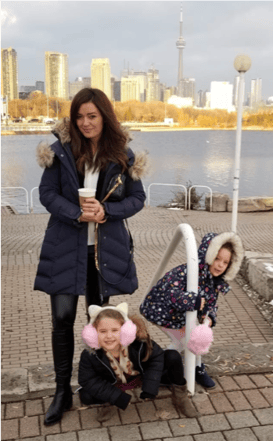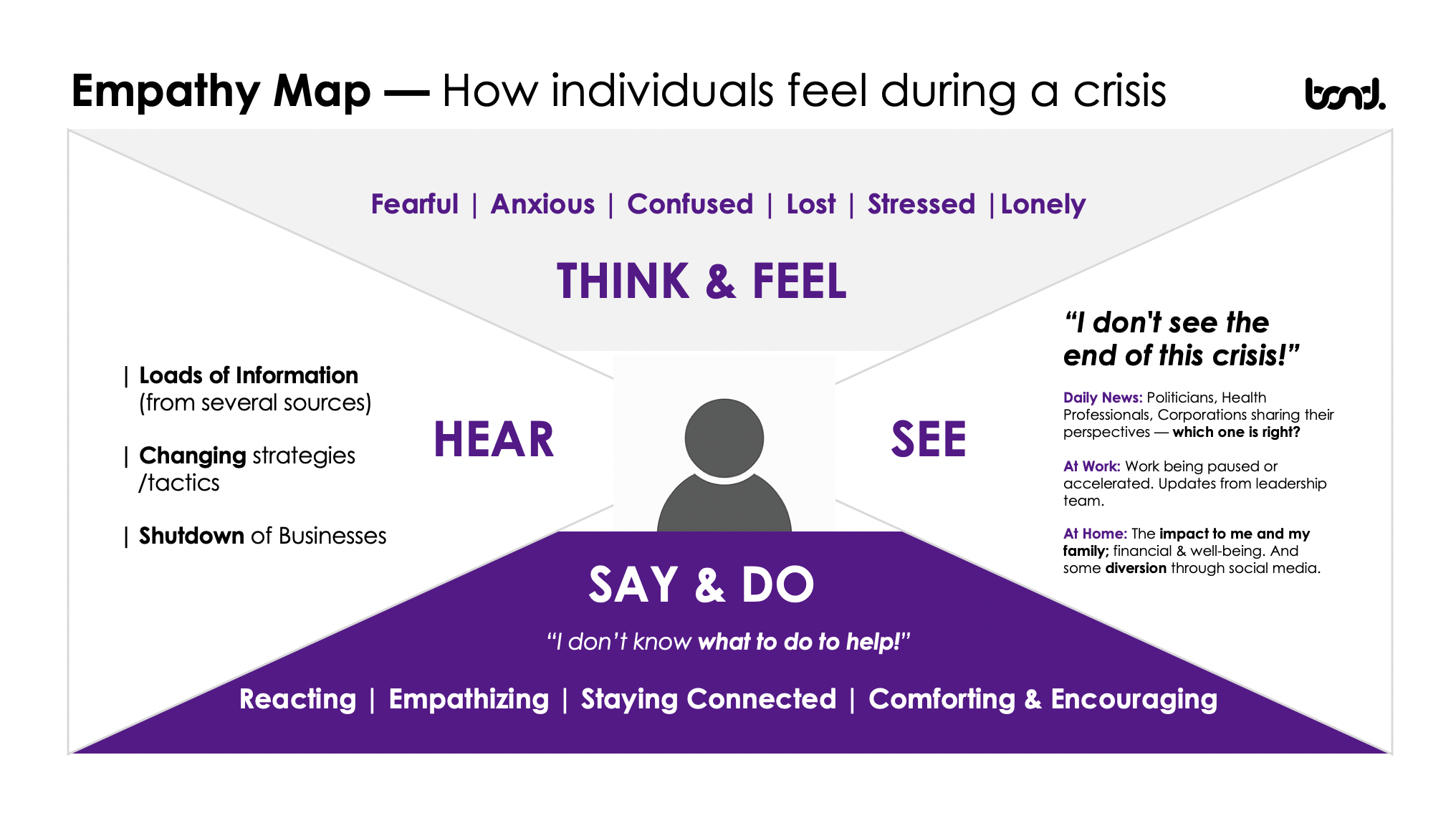Morana Bakula
Why You Shouldn’t Play it Safe in Dangerous Times


First, Hello. Wherever you may be in the world, whatever the phase of grief you may be going through, I hope you are well and safe. Second, thank you for taking a moment to read this. If you are like me, looking for a productive way through this, I hope this piece provides some practical know-how on the things that we can do now for the customers, employees, and brands whom we want to see get through this, and thrive for many years to come.
Long before the Covid-19 pandemic, some of the world’s most successful companies have used Design Thinking to help them unlock whitespace in product, service, and experience differentiation. Design Thinking is a creative, human-centered, iterative approach to solving problems.
It is my belief that Design Thinking is one of the most powerful and valuable tools for any organization that is struggling to navigate during this crisis, prepare for recovery, and be ready to succeed in the post-COVID-19 world.
There is no shortage of content and expertise available on this topic. In recent years, more businesses have started to pay an increasing amount of attention to the application of Design Thinking to help innovate and transform existing products and services. There are dozens of models and methods that make up the Design Thinking toolkit; however, we believe the incredible value that it provides at this time lies in four simple actions that are:
- Human Centered
- Optimistic
- Co-creative
- Iterative
Whether you are focused on Customers, Employees, or Channel Partners (Dealers, Franchises, Salon Owners), these actions can be applied to help you build more resilient and future-ready businesses.
Here are some thoughts on each, with a deeper focus on human centered and optimism, because no matter what role you play in your organization, these are two you can start practicing immediately.
.jpg?width=875&name=GettyImages-1216403160%20(1).jpg)
1. HUMAN CENTERED
In the last decade, customer centricity and employee centricity have become standard speak in business management. However, arguably for many brands, these terms have not gone much beyond fancy language in management presentations and annual reports. Too often decisions have been made based on the primary objective of increasing shareholder value, vs. shareholder value being an outcome of making decisions that put employees and customers first.
We are now experiencing the consequences of this thinking, as we realize that taking better care of our employees, and doing business with our customers on their terms (where and how they want), might have built more resilient businesses. This is an opportunity to design a stronger future by taking a human-centric approach. To do so, we need to:
a. Empathize
Our ability to understand the feelings of others—our customers, employees, and partners is perhaps the most powerful resource we have. This extends well beyond the way our users engage with a service, product, or experience. We need to think about our users/audiences in their lives:
- What are they thinking, feeling, hearing, seeing?
- What might they be thinking, feeling, hearing, seeing, as the world starts to recover? As we move into a new normal?
- What do their lives look like today? What will they look like tomorrow?
 Applying empathy frees us from our own minds (a welcome experience for most these days). It allows us to let go of our own judgments, biases, and assumptions by focusing on others. In doing so, we are able to generate new ideas and approaches that we might not have otherwise been able to.
Applying empathy frees us from our own minds (a welcome experience for most these days). It allows us to let go of our own judgments, biases, and assumptions by focusing on others. In doing so, we are able to generate new ideas and approaches that we might not have otherwise been able to.
b. Engage
One of the best ways to empathize is to invite your customers and your employees to design your future with you. Your most loyal customers are a great place to start. You can do this by conducting phone interviews, or by hosting virtual co-design sessions. This will give you an opportunity to hear their stories, their experiences, and unearth more meaningful insights about their needs. These insights will undoubtedly point you to the experiences, services, and products you might want to provide.
c. Imagine
It is relatively easy to understand what employees and customers need now, but anticipating and being ready for Recovery and the New Normal are murky at best. Although we may not be able to predict the future, we can imagine it. In doing so we can be readier for it.
Here are some useful techniques to help imagine what might be:
- Storytelling: Write a story about the world in recovery and the new normal. For example:
- During Recovery: Is everything by appointment only? How are restaurants redesigning services so people can enjoy a meal outside their homes? What do vacations look like if we can’t leave the country or can only travel at certain times of the year?
- New World: Is everything back to the way it was? Until a vaccine is found, are we living in a two-tier society (the immune/recovered vs. those who are not)? What are customers expecting on planes? Are we testing ourselves every morning before we leave our homes, and how are we sharing the data? Is technology being used to track our whereabouts through our mobile devices and purchase activities?
-
Designing for Extremes: By anticipating extreme cases we can design services, products, and experiences to meet the needs of all users. Considering extremes helps us isolate the things that will be common to all audiences. This can serve as powerful tool to guide what you should focus on (in terms of investment, time, effort).
2. OPTIMISTIC
Constraints are part of the innovation process, and it is likely that every new idea will have multiple hurdles to overcome (especially at this time). Some you might choose are not worth overcoming (the risk vs. reward evaluation, the cost versus return, etc.); however, you can increase the chance of success for new ideas through a good healthy dose of optimism. A few simple techniques:
- Ask “what if?” The world has shifted and for many businesses, very little is as it was before. This is a difficult reality, but it also provides new opportunities to serve customers, employees, and societies in new and meaningful ways. Here are a few examples:
-
What if Sysco Foods used the power of its supply chain to serve customers directly?
-
What if Ford re-tooled its manufacturing plants to provide life-saving medical equipment?
-
-
Challenge anyone (including yourself) to determine if there is any version of “we haven’t done it that way” or “we don’t do it that way,” “we’re not ready for digital transformation,” or “it’s too complicated.” You are right. So instead ask, “How might we do it?” Each of the examples above answered this question.
- Ask “why” 5 times. It is as frustrating as when a child does it, but highly effective in pointing to the different root causes of a problem. This will generate a different approach than you might have otherwise taken.
3. CO-CREATIVE
We can increase our chances of generating better ideas and innovations by inviting different perspectives. This includes employees from different parts of the business, channel partners, and customers. Diversity of thought and expertise promotes expansive thinking. Perhaps, most importantly at this time, it allows us to move with pace making sure we have taken into account broad considerations (technology, marketing, strategy, compliance, etc.) as we seek to rapidly design, test, and implement new ideas. An efficient way to do this is through dedicated Design sprints that involve cross-functional expertise.

4. ITERATIVE
We have to shed the practices that slow us down, like robust business cases and layers of committees, to make decisions on ideas that can quickly make a difference for our customers, employees, and companies. Instead, think like start-ups with every new idea you want to implement—pretotype, fail fast, pivot, learn quickly, optimize, implement.
Our lives, our teams, our businesses have been dramatically disrupted. However, each of us has an ability to use this crisis as an opportunity to design a stronger future for our employees, customers, and channel partners. It is, in Design Thinking speak, “a wicked problem” to solve. I am excited by all that we will create by applying a bit of imagination, optimism, and humanity.